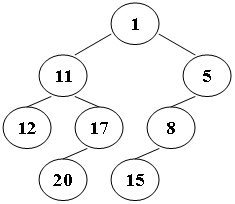文章目录
Author: CHEN, Yue
Organization: 浙江大学
Time Limit: 400 ms
Memory Limit: 64 MB
Code Size Limit: 16 KB
A1127 ZigZagging on a Tree (30point(s))
Suppose that all the keys in a binary tree are distinct positive integers. A unique binary tree can be determined by a given pair of postorder and inorder traversal sequences. And it is a simple standard routine to print the numbers in level-order. However, if you think the problem is too simple, then you are too naive. This time you are supposed to print the numbers in “zigzagging order” – that is, starting from the root, print the numbers level-by-level, alternating between left to right and right to left. For example, for the following tree you must output: 1 11 5 8 17 12 20 15.

zigzag.jpg
Input Specification:
Each input file contains one test case. For each case, the first line gives a positive integer N (≤30), the total number of nodes in the binary tree. The second line gives the inorder sequence and the third line gives the postorder sequence. All the numbers in a line are separated by a space.
Output Specification:
For each test case, print the zigzagging sequence of the tree in a line. All the numbers in a line must be separated by exactly one space, and there must be no extra space at the end of the line.
Sample Input:
8
12 11 20 17 1 15 8 5
12 20 17 11 15 8 5 1
Sample Output:
1 11 5 8 17 12 20 15
Code
#include <stdio.h>
#include <iostream>
#include <vector>
#include <queue>
using namespace std;
struct NODE{
int data,level;
struct NODE *lchild,*rchild;
};
vector<int> postorder,inorder,res[50];
NODE *build(int postL,int postR,int inL,int inR){
if(postL>postR) return NULL;
NODE* root=new NODE;
root->data=postorder[postR];
int i;
for(i=inL;i<=inR;i++) if(postorder[postR]==inorder[i]) break;
int lcnt=i-inL;
root->lchild=build(postL,postL+lcnt-1,inL,i-1);
root->rchild=build(postL+lcnt,postR-1,i+1,inR);
return root;
}
void zlevelorder(NODE *root){
queue<NODE*> q;
root->level=1;
q.push(root);
while(!q.empty()){
NODE* temp=q.front();
q.pop();
res[temp->level].push_back(temp->data);
if(temp->lchild!=NULL){
temp->lchild->level=temp->level+1;
q.push(temp->lchild);
}
if(temp->rchild!=NULL){
temp->rchild->level=temp->level+1;
q.push(temp->rchild);
}
}
}
int main(){
int n;
scanf("%d",&n);
postorder.resize(n);
inorder.resize(n);
for(int i=0;i<n;i++) scanf("%d",&inorder[i]);
for(int i=0;i<n;i++) scanf("%d",&postorder[i]);
NODE *root=build(0,n-1,0,n-1);
zlevelorder(root);
printf("%d",res[1][0]);
for(int i=2;i<50;i++){
if(i%2==0) for(int j=0;j<res[i].size();j++) printf(" %d",res[i][j]);
else for(int j=res[i].size()-1;j>=0;j--) printf(" %d",res[i][j]);
}
return 0;
}
Analysis
-另类的层序输出。
-将数存放在一个二位数组res[][]中,第i层的内容存放在res[i]中,当i为奇数时逆向输出,当i为偶数时顺向输出。
